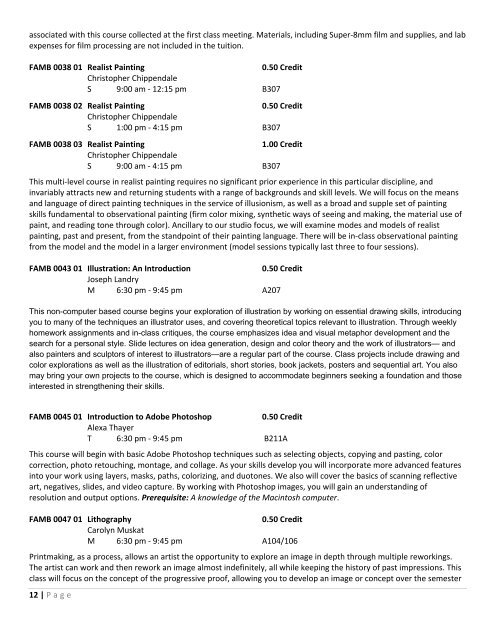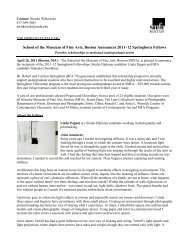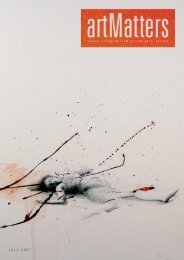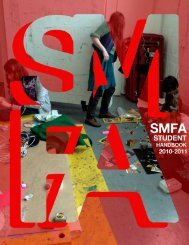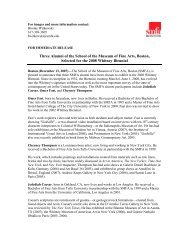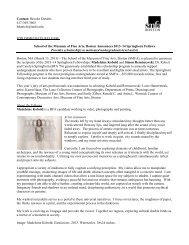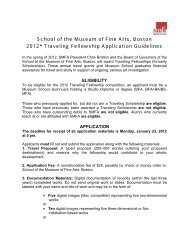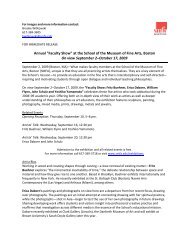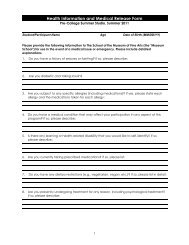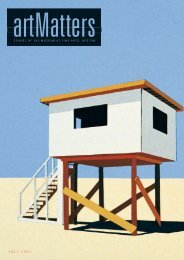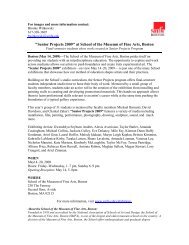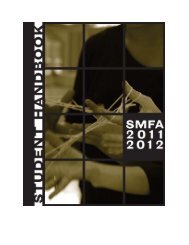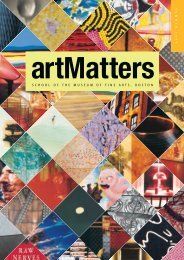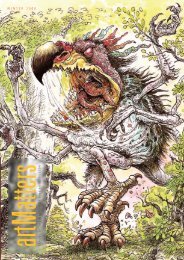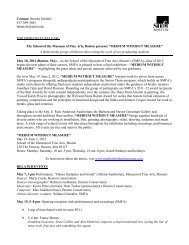Studio Art Courses at Tufts - School of the Museum of Fine Arts
Studio Art Courses at Tufts - School of the Museum of Fine Arts
Studio Art Courses at Tufts - School of the Museum of Fine Arts
Create successful ePaper yourself
Turn your PDF publications into a flip-book with our unique Google optimized e-Paper software.
associ<strong>at</strong>ed with this course collected <strong>at</strong> <strong>the</strong> first class meeting. M<strong>at</strong>erials, including Super‐8mm film and supplies, and lab<br />
expenses for film processing are not included in <strong>the</strong> tuition.<br />
FAMB 0038 01 Realist Painting<br />
0.50 Credit<br />
Christopher Chippendale<br />
S 9:00 am ‐ 12:15 pm B307<br />
FAMB 0038 02 Realist Painting<br />
0.50 Credit<br />
Christopher Chippendale<br />
S 1:00 pm ‐ 4:15 pm B307<br />
FAMB 0038 03 Realist Painting<br />
1.00 Credit<br />
Christopher Chippendale<br />
S 9:00 am ‐ 4:15 pm B307<br />
This multi‐level course in realist painting requires no significant prior experience in this particular discipline, and<br />
invariably <strong>at</strong>tracts new and returning students with a range <strong>of</strong> backgrounds and skill levels. We will focus on <strong>the</strong> means<br />
and language <strong>of</strong> direct painting techniques in <strong>the</strong> service <strong>of</strong> illusionism, as well as a broad and supple set <strong>of</strong> painting<br />
skills fundamental to observ<strong>at</strong>ional painting (firm color mixing, syn<strong>the</strong>tic ways <strong>of</strong> seeing and making, <strong>the</strong> m<strong>at</strong>erial use <strong>of</strong><br />
paint, and reading tone through color). Ancillary to our studio focus, we will examine modes and models <strong>of</strong> realist<br />
painting, past and present, from <strong>the</strong> standpoint <strong>of</strong> <strong>the</strong>ir painting language. There will be in‐class observ<strong>at</strong>ional painting<br />
from <strong>the</strong> model and <strong>the</strong> model in a larger environment (model sessions typically last three to four sessions).<br />
FAMB 0043 01 Illustr<strong>at</strong>ion: An Introduction<br />
0.50 Credit<br />
Joseph Landry<br />
M 6:30 pm ‐ 9:45 pm A207<br />
This non-computer based course begins your explor<strong>at</strong>ion <strong>of</strong> illustr<strong>at</strong>ion by working on essential drawing skills, introducing<br />
you to many <strong>of</strong> <strong>the</strong> techniques an illustr<strong>at</strong>or uses, and covering <strong>the</strong>oretical topics relevant to illustr<strong>at</strong>ion. Through weekly<br />
homework assignments and in-class critiques, <strong>the</strong> course emphasizes idea and visual metaphor development and <strong>the</strong><br />
search for a personal style. Slide lectures on idea gener<strong>at</strong>ion, design and color <strong>the</strong>ory and <strong>the</strong> work <strong>of</strong> illustr<strong>at</strong>ors— and<br />
also painters and sculptors <strong>of</strong> interest to illustr<strong>at</strong>ors—are a regular part <strong>of</strong> <strong>the</strong> course. Class projects include drawing and<br />
color explor<strong>at</strong>ions as well as <strong>the</strong> illustr<strong>at</strong>ion <strong>of</strong> editorials, short stories, book jackets, posters and sequential art. You also<br />
may bring your own projects to <strong>the</strong> course, which is designed to accommod<strong>at</strong>e beginners seeking a found<strong>at</strong>ion and those<br />
interested in streng<strong>the</strong>ning <strong>the</strong>ir skills.<br />
FAMB 0045 01 Introduction to Adobe Photoshop<br />
0.50 Credit<br />
Alexa Thayer<br />
T 6:30 pm ‐ 9:45 pm B211A<br />
This course will begin with basic Adobe Photoshop techniques such as selecting objects, copying and pasting, color<br />
correction, photo retouching, montage, and collage. As your skills develop you will incorpor<strong>at</strong>e more advanced fe<strong>at</strong>ures<br />
into your work using layers, masks, p<strong>at</strong>hs, colorizing, and duotones. We also will cover <strong>the</strong> basics <strong>of</strong> scanning reflective<br />
art, neg<strong>at</strong>ives, slides, and video capture. By working with Photoshop images, you will gain an understanding <strong>of</strong><br />
resolution and output options. Prerequisite: A knowledge <strong>of</strong> <strong>the</strong> Macintosh computer.<br />
FAMB 0047 01 Lithography<br />
0.50 Credit<br />
Carolyn Musk<strong>at</strong><br />
M 6:30 pm ‐ 9:45 pm A104/106<br />
Printmaking, as a process, allows an artist <strong>the</strong> opportunity to explore an image in depth through multiple reworkings.<br />
The artist can work and <strong>the</strong>n rework an image almost indefinitely, all while keeping <strong>the</strong> history <strong>of</strong> past impressions. This<br />
class will focus on <strong>the</strong> concept <strong>of</strong> <strong>the</strong> progressive pro<strong>of</strong>, allowing you to develop an image or concept over <strong>the</strong> semester<br />
12 | P age


